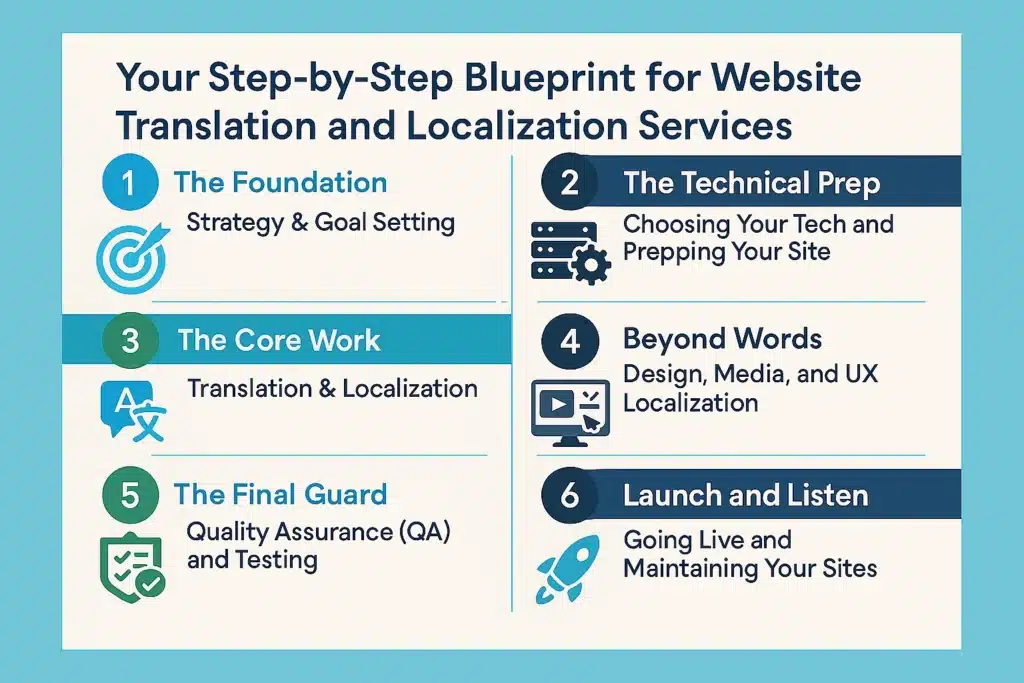Have a Big Project?
Big numbers, lots of documents and multiple translations?
Our top performing teams deliver unmatched quality on time for you
to hit your business goals.

Let’s start with a hard truth: the world doesn’t care that your website is in English.
Shocking, right? But hear me out. With English speakers making up only about 25% of global internet users, you’re effectively turning away three-quarters of your potential audience by staying in a single language. You’re leaving revenue, brand loyalty, and market share on the table for competitors who are willing to meet customers in their language.
But here’s where most businesses panic and make a critical mistake. They think slapping a Google Translate widget on their site is the answer. It’s not. It’s a fast track to embarrassing cultural faux pas, confusing user experiences, and a shattered brand reputation.
Truly going global isn’t about website translation alone. This is where professional website translation and localization services come in.
Before we get into the “how”, let’s solidify the “why.” Investing in professional website translation and localization services is a powerful business growth strategy with a staggering ROI.
Here’s what the data says:
A pivotal study by CSAResearch found that 76% of online shoppers prefer to buy products with information in their native language, and a massive 40% will never buy from a website that isn’t in their language. This isn’t a preference; it’s a barrier to entry.
Common Sense Advisory’s research (now part of CSA) also revealed that 56% of consumers stated that the ability to obtain information in their own language is more important than price. They value understanding what they’re buying more than a small discount. This loyalty translates to higher customer lifetime value.
When you speak to your global audience in their language and reflect their culture, you’re not just selling—you’re building a relationship. A localized experience shows respect and commitment to their market, fostering deep brand trust that competitors can’t easily replicate.
Tapping into emerging target markets is one of the most effective ways to grow your business. While your competitors are still figuring it out, a robust localization process allows you to establish a first-mover advantage and become the trusted brand in that region.
Professional website translation services that properly implement hreflang tags and create locally relevant content allow you to rank on international search engines. This means free, targeted traffic from your new target audience searching in their language.
Simply put, ignoring localization means you’re invisible to a huge portion of the internet. Leveraging it is the key to unlocking sustainable global growth.

You wouldn’t build a house without a blueprint. Don’t launch into a global expansion without one, either. This first step is all about moving from a “we should be global” vibe to a concrete, data-backed plan.
Your website’s architecture can make or break your localization efforts. This step is about ensuring your site can technically handle multiple languages seamlessly.
This technical groundwork, often called internationalization (i18n), is the non-negotiable foundation for any successful website translation and localization project, and it’s absolutely critical for web application localization services due to the dynamic, user-specific content often displayed.
This is the meat of the project. It’s where words are changed, but more importantly, where meaning is culturally adapted.
Your translation method impacts both cost and quality.
| Approach | Best For | Pros | Cons |
| Machine Translation (MT) | Bulk, fast-changing content | Speed, low cost | Poor nuance, tone issues |
| Human Translation | Marketing, branding, legal | Cultural accuracy, creativity | Slower, higher cost |
| Hybrid (MT + Human Editing) | Mixed content | Scalable balance | Needs skilled editors |
Your text is perfect. Now, make sure the rest of the experience is too. A localized website feels like it was born there.
You cannot skip this. Launching a poorly tested localized site is worse than not launching one at all.
Your launch is not the finish line; it’s the starting line of your global presence.
Investing in professional website translation and localization services isn’t a cost center; it’s one of the highest-return growth strategies available today. It’s how you show respect, build trust, and unlock the massive potential of the global market.
By following this step-by-step guide, you’re not just translating words—you’re building bridges. And on the other side of those bridges are millions of new customers waiting to welcome you.
Ready to Go Global? Let Torjoman Be Your Guide
Navigating the complexities of website translation and localization can feel daunting, but you don’t have to do it alone. This is precisely where a dedicated partner like Torjoman shines.
Torjoman provides comprehensive website translation and localization services designed to handle every step of this process for you. From seamless technical integration that respects your site’s SEO to connecting you with a curated network of vetted professional translators and native speakers, they remove the heavy lifting.
Their expertise ensures your brand’s voice is preserved across cultures, your user experience is flawless in every language, and your global expansion is built on a foundation of quality and precision. Why juggle multiple vendors and complex localization management when you can have a single, powerful solution?
Stop leaving global revenue on the table. Visit Torjoman’s Website Localization Services page today to learn how their tailored solutions can help you connect with your global audience, enter new target markets with confidence, and transform your website into a true global powerhouse.
Big numbers, lots of documents and multiple translations?
Our top performing teams deliver unmatched quality on time for you
to hit your business goals.
Ready to burst your borders and need work done quickly?
Order Now! To get an instant assessment and quote.
Don’t wait, we’re ready.
SAVE TIME & MONEY!
Order from our mobile app now